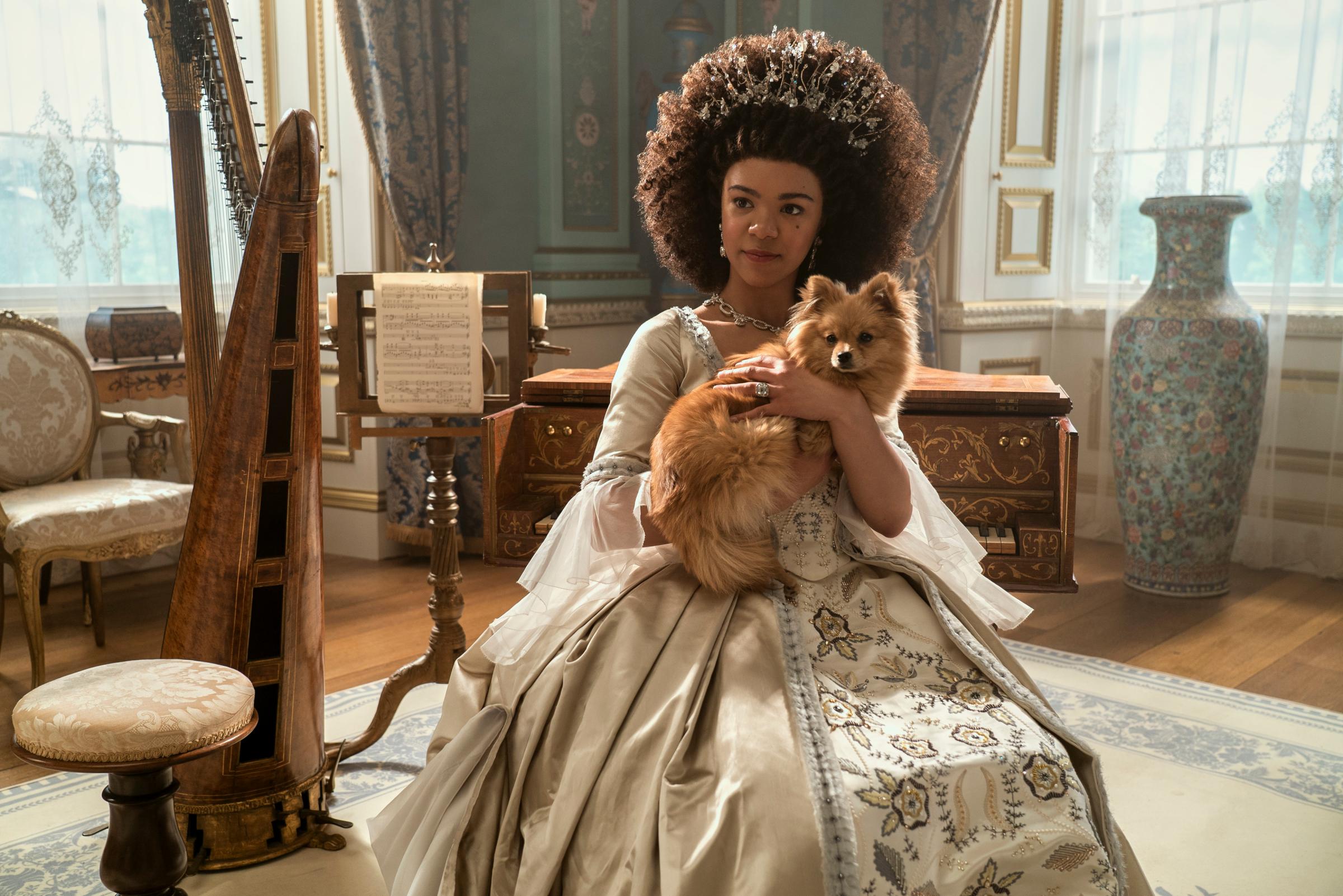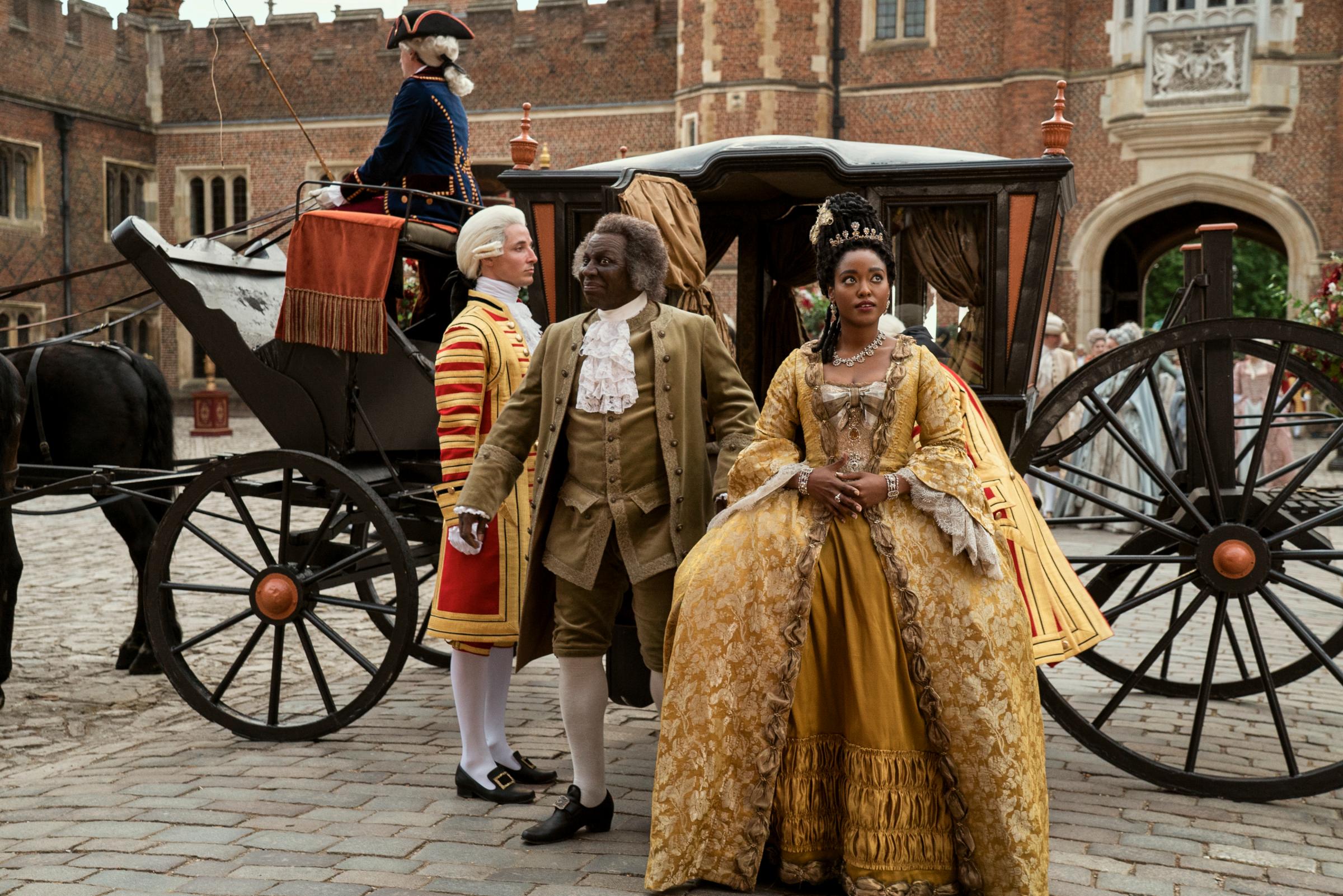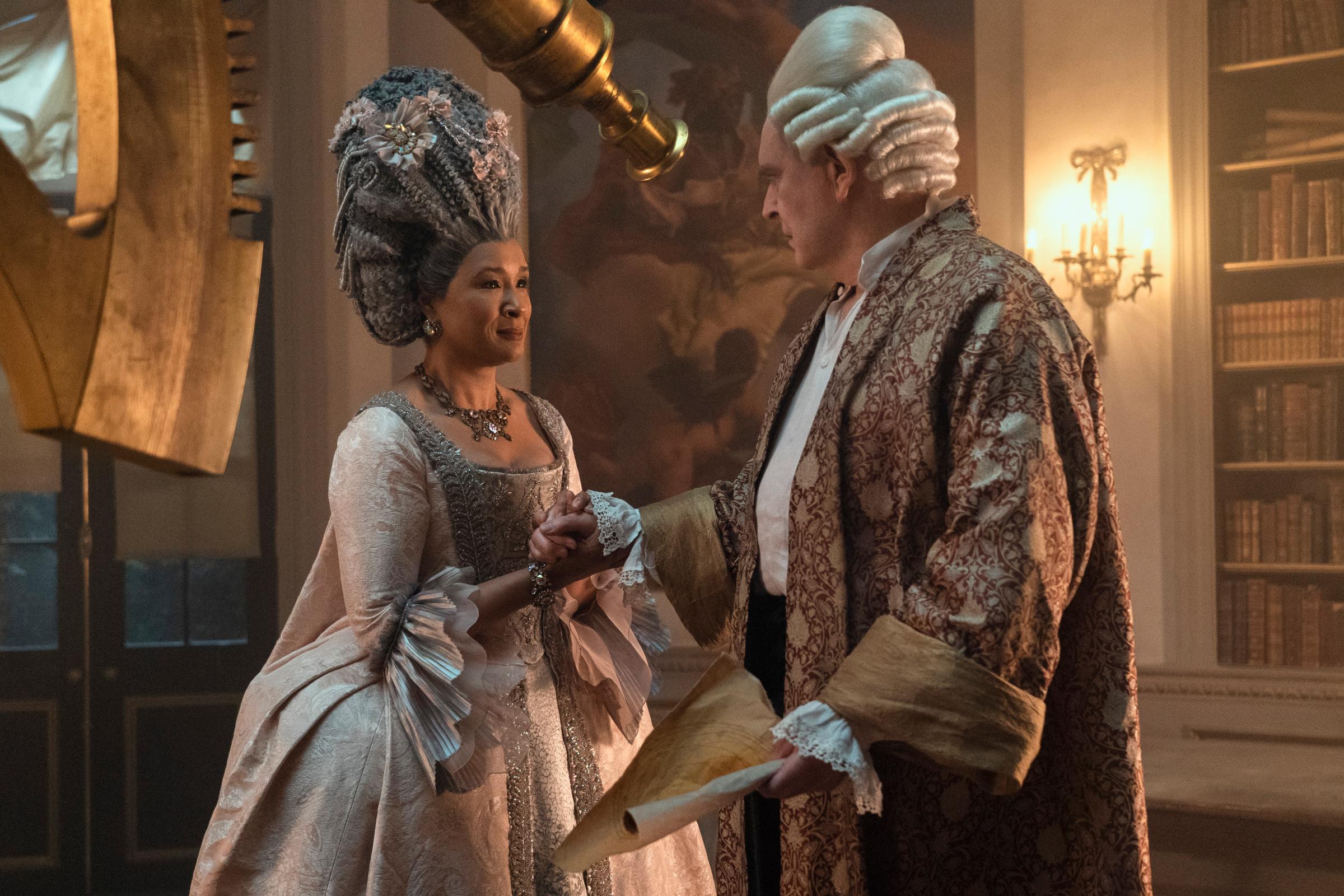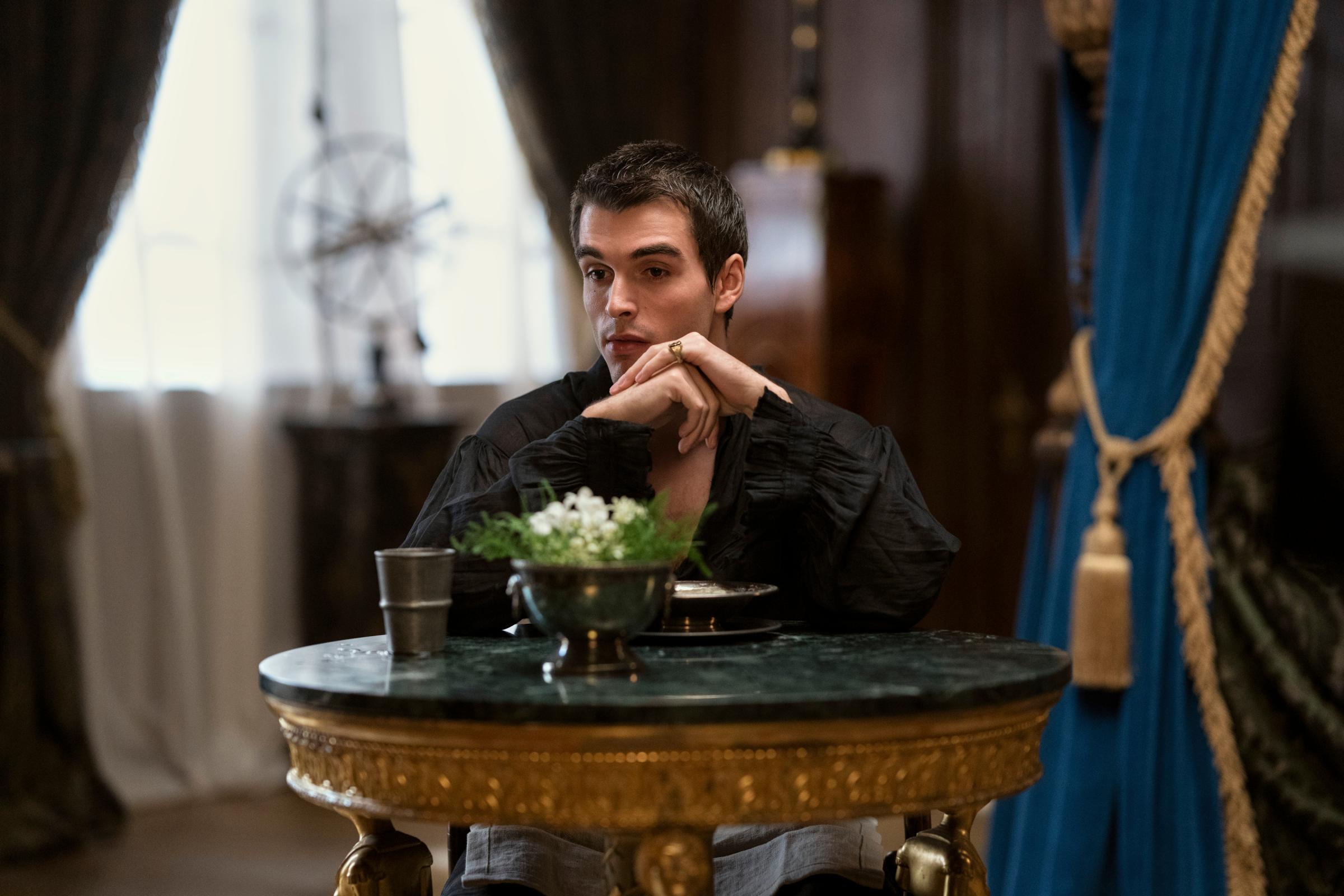The first episode of the Bridgerton prequel series, Queen Charlotte: A Bridgerton Story, opens with a disclaimer from none other than the notorious Lady Whistledown. In her note, she states that the royal’s story “is not a history lesson,” but instead, “fiction inspired by fact,” where “all liberties taken by the author are quite intentional.” While the show, which released this week on Netflix, definitely takes many liberties while spinning the tale of the epic romance between Queen Charlotte and her beloved husband, King George III of England, the characters were actually inspired by the real-life British monarchs of the same names.
In the series, which jumps between the early years of Charlotte and George’s marriage during the early Georgian period (around the 1760s) and the Regency era (the early 1800s) of Bridgerton, viewers get a glimpse of two different Charlottes: the dynamic and grandiose Queen Charlotte (Golda Rosheuvel) they know from previous installments of Bridgerton seasons, and the fiercely independent 17-year-old German Princess Charlotte (India Amarteifio), who’s set to wed George III, the King of England (Corey Mylchreest). Both Charlottes face challenges—the older Charlotte, despite having given birth to 13 living heirs, has no legitimate grandchildren to ensure that their bloodline endures, while the younger Charlotte must navigate a new country, the mysteries of marriage with a contrary husband, and perhaps most pressing, the tensions that arise with her interracial marriage, which not only makes her the first Black royal, but also leads to the integration of the “ton,” or British high society.
Read more: From Bridgerton to Sanditon, We Can’t Quit the Regency Era
While Bridgerton, with its colorblind casting, rarely centered racial issues, Queen Charlotte, a true Shonda Rhimes joint, doesn’t shy away from making race an integral part of multiple story lines, addressing everything from colorism to segregation and integration. But while these important themes help to make the show a captivating and thought-provoking watch, there’s definitely a liberal blurring of the lines between history and fantasy in the series.
With that in mind, here’s a breakdown of what’s fact and what’s fiction in Queen Charlotte.
Was Queen Charlotte really Black?

One of the major storylines of Queen Charlotte is how the protagonist navigates the trials and triumphs of being the first Black queen of England. However, in real life, it’s debatable whether or not the monarch was actually Black. The character of Charlotte is based on Princess Sophie Charlotte of Mecklenburg-Strelitz, a figure whose racial identity has been in question for decades. Initial speculation about Charlotte being Black or of mixed-race descent began in the 1940s, after the Jamaican-American journalist and historian J.A. Rogers theorized in his book Sex and Race: Volume I that because of the facial features she was depicted with in portraits, which he identified as “broad nostrils and heavy lips,” she may have been part Black.
While Rogers posited this to confront the problematic belief in a “pure white race,” the theory was revisited by historian historian Mario De Valdes y Cocom in a 1997 piece for PBS Frontline (which was later edited due to outdated and offensive language), where he makes the case that Charlotte was Black because she was a direct descendant of Margarita de Castro y Sousa, a Black branch of the Portuguese royal house through Margarita de Castro e Souza, whom The Guardian reports was “a 15th-century Portuguese noblewoman nine generations removed, whose ancestry she traces from the 13th-century ruler Alfonso III and his lover Madragana, whom Valdes takes to have been a Moor and thus a black African.”
However, other historians are doubtful that this proves that Charlotte was Black or of mixed-race descent. In an interview with The Philadelphia Inquirer, academic Ania Loomba said that the assumption that Charlotte was Black because her ancestry included descriptions of “moors” relies on an inaccurate understanding of history.
“The word ‘blackamoor’ in Shakespeare’s time meant Muslim,” Loomba said. “It didn’t mean Black necessarily. Moors could be white from North Africa.”
Did “The Great Experiment” really exist?

In the series, Charlotte’s visibility as the first Black queen of England leads to the crown giving titles to other people of color and inviting them to join the then-segregated court and the “ton,” including a young Lady Agatha Danbury (Arsema Thomas,) who becomes one of the queen’s ladies-in-waiting. The reasoning behind this racial integration, which the powers at court dub “the Great Experiment,” is that it showed support for Charlotte and reinforced the power of the crown in setting the tone and practices for its court and subjects.
In reality, however, “the Great Experiment” never happened—in fact, nothing even close to it even existed. While there were many Black and mixed-race people in England during this time, British society was still heavily segregated. Even by the Regency era, this would have been wildly unrealistic; while slavery was abolished in the British Empire in 1807, slaves weren’t fully free in the British colonies until 1838 and its repercussions are still felt to this day.
Did Queen Charlotte and King George III really have a loving marriage?

In Queen Charlotte, an arranged marriage between the young German princess and the King of England turns into a tumultuous and then passionate meeting of the minds and a true love match. In real life, the actual Charlotte and George had by all accounts a truly loving marriage despite its having been arranged, one that was certainly viewed as successful at that time because of their many children. The couple was married for 57 years, with Charlotte holding the record for Britain’s longest-serving female consort and the second longest-serving consort in British history (Prince Philip, Duke of Edinburgh, is the first). The couple ran into challenges because of George’s mental health issues, which caused him to have episodes of mania, increasingly as he got older. Despite this, Charlotte remained a loving and loyal wife, advocating for the king, until his bouts grew so violent in the early 1800s, that that they were forced to live separate lives for her safety.
What to know about George III’s “madness”

While history may remember George III as the mad king who lost the American colonies, Queen Charlotte depicts him as a complex yet loving man with a deep interest in science and astrology, whose very real struggles with mental health change the scope of his life. In reality, George III’s life paralleled this experience. He was a devoted and loving husband and a ruler known for his interest in and support for culture, science, astronomy, and agriculture. He was responsible for buying what is now known as Buckingham Palace and opened up a library that was free for scholars to use, but his legacy as a king has largely been defined by his mental health struggles.
According to the British Royal Family’s official site, George III had serious episodes of “illness” in 1788-89 and in 1801, before becoming permanently deranged in 1810, rendering him completely mentally unfit to rule in his last decade as the king; during this time, his eldest son, George, acted as the Prince Regent, beginning in 1811. Starting in the 1960s, some medical historians posited that his mental illness may have been caused by a hereditary physical disorder, called porphyria, that mainly affects the skin or nervous system. However, in the years since, other historians and medical researchers have made the case that George III’s behavior is consistent with having bipolar disorder, which can include bouts of mania.
How many children did Queen Charlotte and King George III really have?
In real life, Queen Charlotte and King George III did have a large family. The couple had fifteen children during their six-decade marriage, thirteen of whom lived to adulthood (both Prince Octavius and Prince Alfred died in childhood). Of their children, two went on to rule England—George, The Prince of Wales (later King George IV) and Prince William (later King William IV).
The dilemma of securing a legitimate heir that Queen Charlotte faces later in life in the show was a very real problem in reality for the actual Charlotte. When her granddaughter Princess Charlotte died in childbirth, she was the only legitimate grandchild and heir in the family, despite the many children that George and Charlotte had. Following Princess Charlotte’s death, Queen Charlotte’s sons, who were infamous for fathering illegitimate children with their mistresses, sought suitable matches for royal wives—producing multiple legitimate heirs, including a girl named Victoria, who would eventually become the queen and the second-longest reigning monarch in British history.
More Must-Reads from TIME
- Caitlin Clark Is TIME's 2024 Athlete of the Year
- Where Trump 2.0 Will Differ From 1.0
- Is Intermittent Fasting Good or Bad for You?
- The 100 Must-Read Books of 2024
- Column: If Optimism Feels Ridiculous Now, Try Hope
- The Future of Climate Action Is Trade Policy
- FX’s Say Nothing Is the Must-Watch Political Thriller of 2024
- Merle Bombardieri Is Helping People Make the Baby Decision
Write to Cady Lang at cady.lang@timemagazine.com